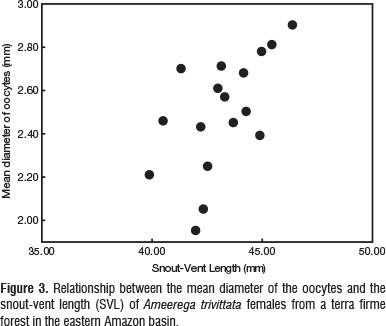The reproductive success of tropical amphibians is influenced by factors such as body size and the characteristics of breeding sites. Data on reproductive biology are important for the understanding of population dynamics and the maintenance of species. The objectives of the present study were to examine the abundance of Ameerega trivittata, analyze the use of microhabitats by calling males and the snout-vent length (SVL) of breeding males and females, the number of tadpoles carried by the males and mature oocytes in the females, as well as the relationship between the SVL of the female and both the number and mean size of the mature oocytes found in the ovaries. Three field trips were conducted between January and September, 2009. A total of 31 plots, with a mean area of 2.3 ha, were surveyed, resulting in records of 235 individuals, with a mean density of 3.26 individuals per hectare. Overall, 66.1% of the individuals sighted were located in the leaf litter, while 17.4% were perched on decaying tree trunks on the forest floor, 15.7% on the aerial roots of Cecropia trees, and 0.8% on lianas. Males were observed transporting a mean of 10.8 tadpoles on their backs. A significant correlation was found between the size of the females and the mean diameter of the oocytes. New data were collected on the size of oocytes and no pattern was found in the type of perches used by calling males of the different Ameerega species.
Calling site; oocyte size; sexual dimorphism; tadpole transportation






